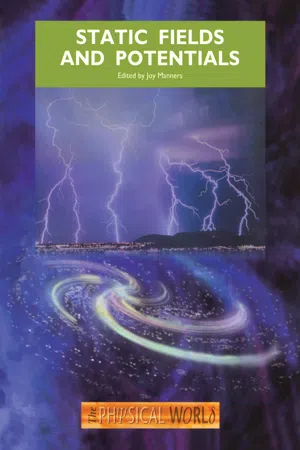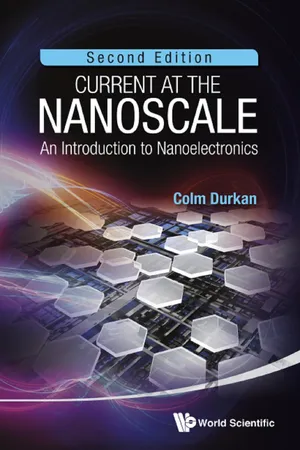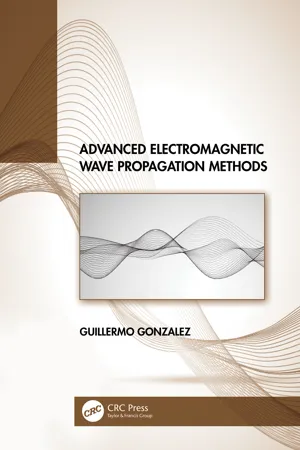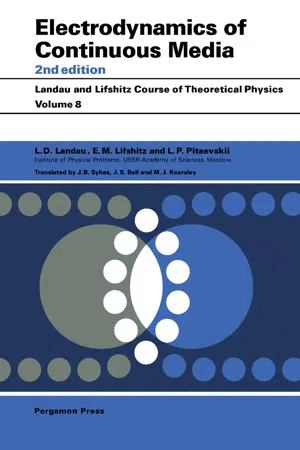Physics
Current Density
Current density refers to the amount of electric current flowing through a given cross-sectional area of a conductor. It is a vector quantity, with both magnitude and direction, and is typically denoted by the symbol J. Current density is an important concept in physics, particularly in the study of electromagnetism and the behavior of conductive materials.
Written by Perlego with AI-assistance
Related key terms
Related key terms
1 of 4
Related key terms
1 of 3
8 Key excerpts on "Current Density"
- eBook - ePub
- A. L. Stanford, J. M. Tanner(Authors)
- 2014(Publication Date)
- Academic Press(Publisher)
J has a magnitude given byJ =(14-30)i A(14-30)Because the direction of J is in the direction of E , the Current Density is in a direction opposite to the flow of electrons.E 14.9
A wire (diameter =1.0 mm) carries a current of 2.5 A. Calculate the magnitude of the Current Density in the wire, assuming that the current is uniformly distributed over a cross section of the wire.Answer: 3.2 ×106 A/m2E 14.10
The magnitude of the Current Density is 2.8 × 104 A/m2 in a wire carrying a current of 3.0 mA. Calculate the cross-sectional area of the wire.Answer: 1.1 ×10−7 m2Resistivity and Ohm’s Law
If certain materials are maintained at a constant temperature, it is found experimentally that the electric field E within those materials is directly proportional to the Current Density J in the material, orE = ρ J(14-31)(14-31)where ρ is a constant called the resistivity of the material. Equation (14–31) is called Ohm’s law for a substance , and materials to which it applies are called ohmic substances. Materials in which E is not proportional to J are known as nonlinear substances. Equation (14–31) reflects the fact that E and J are in the same direction and indicates that the resistivity ρ has the valueρ =(14-32)E J(14-32)Because the unit of E may be expressed as V/m and J has the unit A/m2 , the unit of resistivity ρ is the V · m/A. Table 14.2 lists the resistivities of some common metals at room temperature. It is convenient to define the unit ohm ( - eBook - ePub
- Roger E. Harrington(Author)
- 2012(Publication Date)
- Dover Publications(Publisher)
S is not flat, we must use a surface integral as developed in the preceding section. We then have(2-29)where i is the current through the surface of integration in the reference direction in which d s points and where J is the electric Current Density. The vector picture of Eq. (2-29) would be Fig. 2-9 with B replaced by J .Let us now look a little more closely at the definition of vector Current Density. The mathematical definition of J is(2-30)interpreted as follows: Δi is the current passing through the infinitesimal surface element Δs , which is oriented perpendicular to the direction of flow of Δi and thus intercepts the maximum value of current; ui is a unit vector pointing in the direction of the current and is therefore also the unit vector normal to Δs . Note that this definition is essentially the same as the example represented by Fig. 2-10 , except that it is applied to an infinitesimal area of surface. We call J a “volume distribution” of current, for it specifies the Current Density at all points within a region. However, as implied by the defining equation, J is measured in amperes per square meter . Thus, J appears to be some sort of “surface density.” This paradox can be dispelled by the concept of a current element , defined as the magnitude of a current times the length over which it extends. An element of volume Δτ can be expressed as a cross section Δs perpendicular to the current times a length Δl in the direction of the current; that is, Δτ = Δs Δl . The quantity J Δτ = J Δs Δl = Δi Δl - eBook - ePub
- Roger L. Brauer(Author)
- 2022(Publication Date)
- Wiley(Publisher)
Resistance is a function of the material over which electrons move. If electrical energy or charge is to move from one point to another, there must be a difference in energy level between the two points. There must also be some conductive material that connects the two points.Electrons will flow primarily through the path of least resistance. At times, there is more than one path between two points with each path differing in electrical resistance level.Current Density
Current Density is the amount of current flowing through a conductor per unit of cross‐sectional area. If the area is large, the Current Density is low. If it is small, Current Density is high. Current and Current Density are important for dealing with electrical safety.Resistance
All materials exhibit some resistance to the flow of electricity. Materials that allow electrons to flow easily are conductors. Some good conductors are copper, other metals, water, and electrolytic fluids. Insulators are materials that do not allow electrons to flow easily. Examples of insulators are rubber, glass, wood, air and other gases, and most plastics.The total resistance to the flow of electrons is the sum of all resistances presented by the flow path. One or more materials can create the flow path. For a single material of length l and a given cross‐sectional area, the resistance R is given by:where(12.2 )ρ = resistivity in ohms per unit length σ = conductivity in unit length per ohm Reference tables list resistivity and conductivity of various materials. Equation (12.2 ) shows that resistivity and conductivity are reciprocals, with conductivity the more commonly used property. Table 12-1 gives resistivity for selected copper wire sizes.Heating
A material creating a resistance to electron flow introduces heating, another phenomenon important for electrical safety. The temperature of a conductor will rise as the current flow increases. The energy lost to resistance changes to heat energy, a process called Joule heating. The amount of heat produced can be determined from Joules law: - eBook - ePub
- Michael M. Mansfield, Colm O'Sullivan(Authors)
- 2020(Publication Date)
- Wiley(Publisher)
The amount of mobile charge per unit volume of the conductor is called the mobile charge density and is denoted by the symbol ρ. Suppose that the mobile charge is positive and moves to the right at a constant velocity v, known as the drift velocity. To derive an expression for the current flowing in the conductor in terms of the mobile charge within it, we first determine the amount of charge in a volume of cross‐sectional area A and length ν (Δt), namely Figure 15.6 Electric current in a conductor of uniform cross‐section. and the electric current in the conductor is given by (15.2) Current Density The Current Density at a point in a conductor is defined as Figure 15.7 The Current Density at a point in a current carrying conductor is the current per unit area in the direction of current flow at that point. where ΔI is the current flowing through the area element ΔA and n is a unit vector in the direction of current flow, that is normal to the area ΔA (see Figure 15.7). The current flowing through a conductor of cross‐sectional area A, therefore, is given by and the corresponding Current Density is (15.3) Current Density can be a useful concept as it does not depend on the geometry of the conductor and can be applied to situations where the current is not uniform; we shall use the concept extensively in later chapters. If both types of charge are mobile in the conductor, with positive charge of charge density ρ + moving to the right with speed ν + and negative charge of charge density ρ – moving to the left with speed ν –, the current is given by (15.2a) and the Current Density by (15.3a) Note that both terms in Equations (15.2a) and (15.3a) have the same sign since, taking ‘to the right’ as the positive direction, ρ and v are both negative while ρ + and v + are both positive. Note that Equation (15.3) can be written in vector form as and the corresponding current through any element of area ΔA is given - eBook - ePub
- Joy Manners(Author)
- 2020(Publication Date)
- CRC Press(Publisher)
These atoms are only able to vibrate about their fixed equilibrium positions. So in any solid material, an electric current can be carried only by electrons, which have a negative charge. Consequently, when we say that a positive current is flowing in a certain direction in a wire, we are actually describing a flow of electrons in the opposite direction. However, when indicating the direction of the current flow on a circuit diagram, all that is necessary is to show the direction in which (hypothetical) positive charge would flow. This direction is known as the direction of conventional current flow. Only occasionally will we need to bear in mind that this current is actually produced by electrons moving in the opposite direction. The unit of current, the ampere, takes its name from André-Marie Ampére, a French scientist of the early nineteenth century. In the SI system of units, the ampere (often abbreviated to amp, but more properly represented by the symbol A) is a fundamental unit like the kilogram and the metre. In Section 5.4 of the next chapter, you will see how the amp is defined in terms of an effect discovered by Ampère. For the moment, it is quite correct to say that 1 ampere represents a charge flow of 1 coulomb per second, so 1 A = 1 C s −1. Figure 3.8 The instantaneous current at a point along a wire is defined as the net rate at which charge passes through an area perpendicular to the axis of the wire at that point. The orders of magnitude of the currents involved in some common phenomena and devices are shown in Figure 3.9. Figure 3.9 The orders of magnitude of currents involved in a variety of processes. Example 3.1 If the number density of electrons in a wire is n = 10 28 m −3, at what speed must they travel through a wire of diameter d = 1 mm to deliver a current of 1 A? Solution Consider the flow of electrons past a particular cross-section of a wire with uniform area A (Figure 3.10) - eBook - ePub
Current at the Nanoscale
An Introduction to Nanoelectronics
- Colm Durkan(Author)
- 2013(Publication Date)
- WSPC(Publisher)
1.2. This electric field induces a force on the electrons (of charge, e = −1.6×10 − 19 C) of strength e E, in a direction opposite to that of the applied field (as the electron charge is negative). On this basis, we would therefore expect the electrons to continue to accelerate as they traverse the conductor (cf. Newton’s second law). This flow of charge carriers within a conductor is known as a current, I, and the magnitude of the current in a given direction is the amount of charge (in Coulombs) passing a point in the conductor per second. A current of 1 A (Ampere or Amp) corresponds to 3.25 ×10 18 electrons passing a point per second. Fig. 1.2. Schematic showing current, I, due to a voltage, V, applied to a conductor of length L and cross-sectional area, A. The current, I is defined as the amount of charge per unit time passing a point, which is the number of electrons per unit volume, n, multiplied by the volume, A × L, divided by the time taken to transit the distance, L. This is nAve, where v is the average velocity, or drift velocity of the electrons. Fig. 1.3. The flow of charge in a conductor under an applied electric field, E. On the left, with no voltage applied, the electrons diffuse randomly around, then with a voltage applied, the electrons migrate against the electric field. Considering a single electron, its average motion is along the direction of the electric field, but this is made up of a series of directed random walks each of average length ℓ (the mean free path) - Guillermo Gonzalez(Author)
- 2021(Publication Date)
- CRC Press(Publisher)
E. The proportionality is expressed in the formP =(1.2.13)ε oχ eEwhereχ eis the electric susceptibility. Substituting (1.2.13) into (1.2.11) givesD =(1.2.14)ε o( 1 +Eχ e)The term(is known as the relative permittivity1 +)χ eε r(also known as the dielectric constant). The permittivity of the dielectric ε is given byand (1.2.14) is written asε =(1.2.15)ε oε r=ε o( 1 +χ e)From (1.2.16) the displacement current is defined asD = ε E =(1.2.16)ε oε rE(1.2.17)J d== ε∂ D∂ t∂ E∂ tIt is interesting to note that in electrostatics∇ × E = 0, but from (1.2.11)∇ × D = ∇ × P ≠ 0. Hence, while the electrostatic field E can be expressed as the gradient of a potential, in a dielectric the same cannot be said for D.Matter contains atoms and atoms contain electrons. The spin and orbital motion of electrons around the nucleus give rise to a loop current that can be described by a time-varying magnetic dipole. The current loops are associated with the motion of these electrons in atoms. If there are N atoms per unit volume there is a net magnetization M, which represents the total magnetic dipole moment( N m )per unit volume, and this gives rise to a magnetic Current Density. A magnetic dipole m is represented by time-varying magnetic charges±separated by a distanceq m( t )Δ L. In undergraduate courses it is shown that the magnetization is related to a magnetic Current Density by(1.2.18)J M= ∇ × MwhereJ Mis a bound current. The magnetization current is different from any impressed current. Observe that (1.2.18) shows that∇ •J M= 0- eBook - ePub
- L D Landau, J. S. Bell, M. J. Kearsley, L. P. Pitaevskii, E.M. Lifshitz, J. B. Sykes(Authors)
- 2013(Publication Date)
- Pergamon(Publisher)
CHAPTER IIISTEADY CURRENT
Publisher Summary
In a steady current, the spatial distribution of electric Current Density is independent of time. The electric field in the conductor in which a steady current flows is constant. An electric field in the presence of a current does mechanical work on the current-carrying particles moving in the conductor. This work is dissipated into heat in the conductor. The evolution of heat results in an increase in the entropy of the body. The work required for a thermodynamically reversible removal of the particle is called the work function. This quantity is always positive. The work function depends both on the nature of the conductor and on that of the charged particle. The work function is the characteristic of the surface of the conductor. It, therefore, depends, for instance, on the treatment of the surface and the contamination of it. If the conductor is a single crystal, then the work function is different for different faces.§21 The Current Density and the conductivity
Let us now consider the steady motion of charges in conductors, i.e. steady electric currents. We shall denote by j the mean charge flux density or electric Current Density. † In a steady current, the spatial distribution of j is independent of time, and satisfies the equationdiv j = 0 ,(21.1)(21.1)which states that the mean total charge in any volume of the conductor remains constant. The electric field in the conductor in which a steady current flows is constant, and therefore satisfies the equationcurl E = 0 ,(21.2)(21.2)i.e. it is a potential field.Equations (21.1) and (21.2) must be supplemented by an equation relating j and E. This equation depends on the properties of the conductor, but in the great majority of cases it may be supposed linear (Ohm’s law
Index pages curate the most relevant extracts from our library of academic textbooks. They’ve been created using an in-house natural language model (NLM), each adding context and meaning to key research topics.
Explore more topic indexes
Explore more topic indexes
1 of 6
Explore more topic indexes
1 of 4







